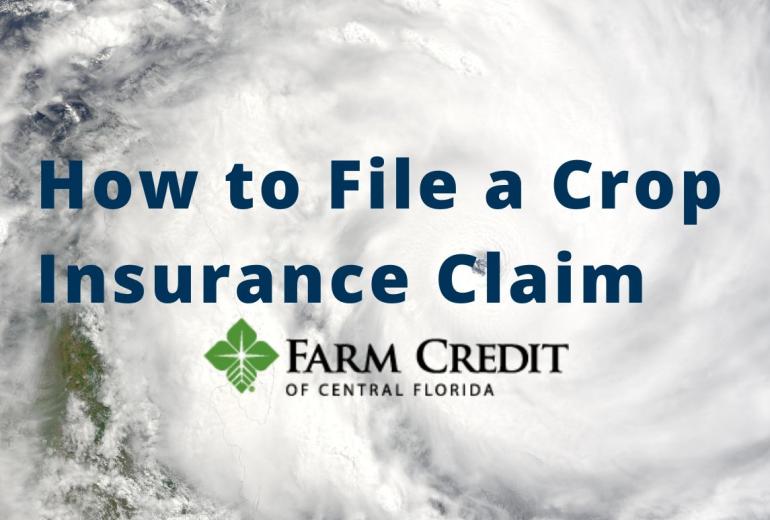How to File a Crop Insurance Claim

What to do.
What not to do.
How do I initiate a claim?
Call your crop insurance agent and follow up in writing/email (keep a copy for your records). Your crop insurance company will arrange for a loss adjuster to inspect your crop. It is your responsibility to call your crop insurance agent and initiate this process.
How do I know when to file a claim?
Crop Damage
Any time you have crop damage that will adversely affect your yield or the value of your crop, you may be eligible to file a claim. The loss adjuster will determine whether your yield falls below the yield guarantee stated in your crop insurance policy. This applies to revenue guarantee policies, as well as, to traditional yield protection policies.
Most policies state that you (the insured) should notify your agent within 72 hours of discovery of crop damage. As a practical matter, you should always contact your agent immediately when you discover crop damage. In some cases, you may discover a loss while you are harvesting (a row crop for instance). Stop harvesting and contact your agent right away.
In the event of losses discovered after harvest, you must file notice immediately after each unit is harvested (within 15 days) and before the end of the insurance period.
How soon should I expect an adjuster?
In practice, there are different levels of urgency for crop inspectors.
If you are still within the window of opportunity to replant your crop, or switch to another crop, contact your crop insurance agent immediately.
The insurance company should make every effort to get an adjuster out right away.
If, later in the growing season, your crop is wiped out by a hurricane, for example, or if a severe drought has damaged your crop, you still need to contact your agent — but the urgency for an inspection depends on your intentions.
If you want to destroy the crop (perhaps to plant a cover crop), then an adjuster needs to come out first — before you do anything. If, on the other hand, you intend to continue to care for the crop and harvest what you can, there is less urgency for the adjuster to make the inspection immediately. Even so, an assessment of damage should be done as soon as practical.
While you wait for the adjuster, remember these rules: Do not destroy any of your crop. Do not disk. Do not plow. Do not replant. Do nothing to destroy your crop until you have permission from a claims adjuster or an insurance company representative.
Remember: Don’t destroy the evidence.
What should I expect from the adjuster?
The adjuster should contact you to schedule an inspection. He or she will expect and welcome your presence and help during the inspection. The adjuster will be interested in what you have to say.
You can expect the adjuster to be familiar with your policy and to explain your options.
You should have your production or harvest records ready to show the number of acres and locations of your insured crops.
The adjuster should have copies of your crop insurance policy documents and your Actual Production History (APH).
How is my crop yield calculated?
For some crops, counting plants within a sample area at various locations in the field is a part of the process. For other crops, determining the pounds of blueberries per bush is part of the process.
Adjusters may take pictures of your fields. They may check with your neighbors on the condition of their crops and they may check with the local broker for average yields in the area. They may even consult local weather data.
Calculating crop yield is not guesswork. It is a disciplined process. Your adjuster has extensive classroom and field training and is constantly studying to maintain his or her certification.
Your responsibilities:
Report crop damage promptly:
• Before replanting (many policies have replanting payments),
• Within 72 hours of discovery of damage,
• 15 days before harvest begins (if loss is possible),
• Within 15 days after harvesting is completed (by insurance unit) or the end of the insurance period.
Caution: Do not destroy evidence that is needed to support your claim without clear direction from the insurance company, preferably in writing.
United States Department of Agriculture Risk Management Agency
Sources:
How to Claim a Crop Insurance Claim
Claims Process
Farm Credit of Central Florida is an equal opportunity provider. In accordance with Federal law and U.S. Department of Agriculture {USDA) civil rights regulations and policies, the USDA, its Agencies, offices and employees and institutions participating in or administering USDA programs are prohibited from discriminating on the basis of race, color, national origin, religion, sex, gender identity (including gender expression), sexual orientation, disability, age, marital status, family/parental status, income derived from a public assistance program, political beliefs, or reprisal or retaliation for prior civil rights activity, in any program or activity conducted or funded by USDA (not all bases apply to all programs). To view this Non-Discrimination policy in more detail please click here.